Management Accounting Practices: Contemporary Techniques and Analysis
VerifiedAdded on 2020/02/19
|23
|5045
|36
Report
AI Summary
This report delves into the multifaceted world of management accounting, examining its evolving practices and the pivotal role of management accountants in the contemporary business landscape. The report explores the key focus areas of management accounting, emphasizing the performance and profitability factors, and how these practices are adapted to meet the demands of a globalized and competitive market. It provides a literature review that highlights the changes in management accounting practices, the management accountant's responsibilities, and the significance of customer value and shareholder wealth. Furthermore, the report discusses contemporary techniques of resource management, such as economic batch quantity, ABC costing, and total quality management, illustrating their importance in optimizing business operations and achieving organizational goals. The report provides an in-depth analysis of these aspects, making it a valuable resource for understanding the dynamics of modern management accounting.
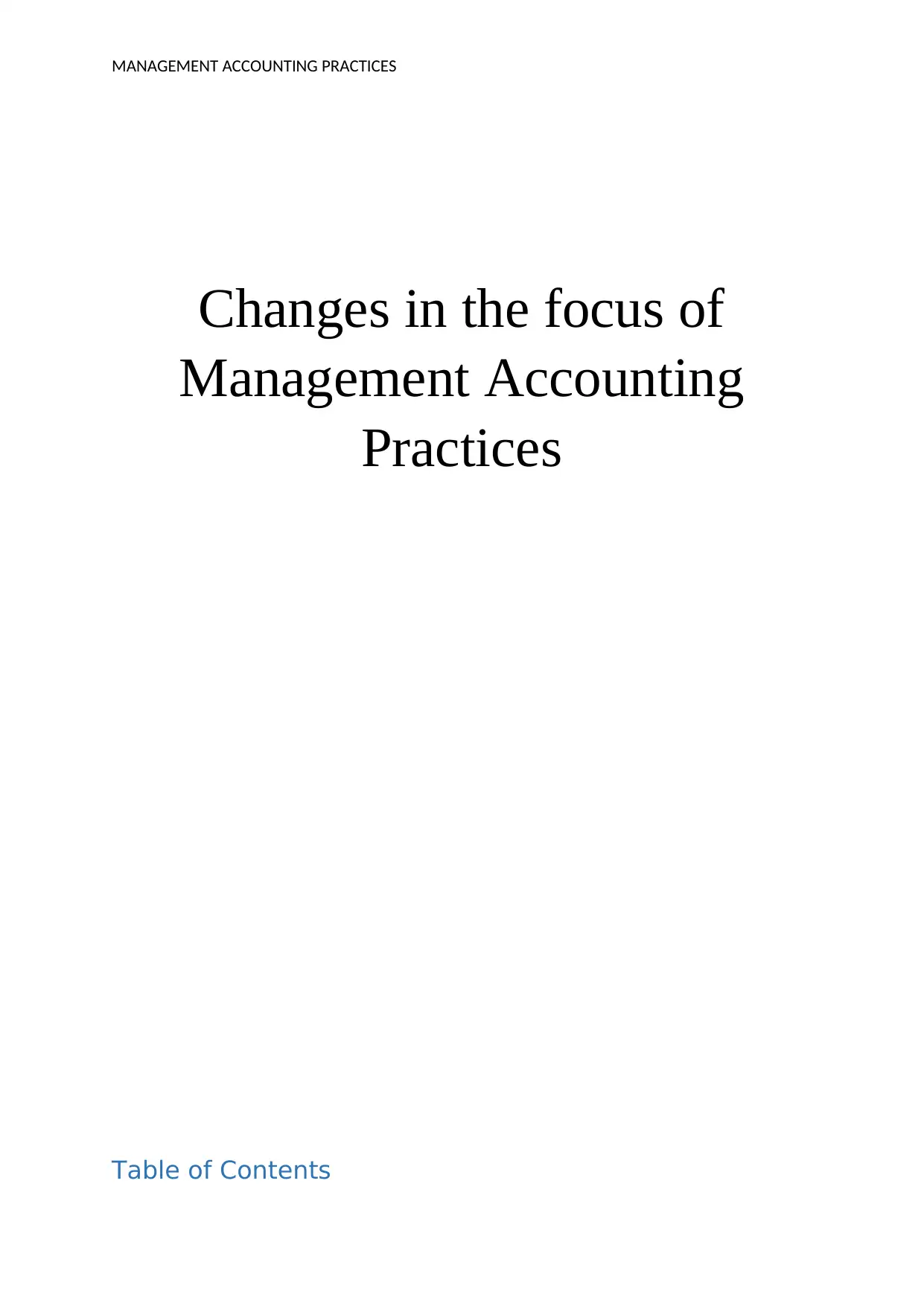
MANAGEMENT ACCOUNTING PRACTICES
Changes in the focus of
Management Accounting
Practices
Table of Contents
Changes in the focus of
Management Accounting
Practices
Table of Contents
Paraphrase This Document
Need a fresh take? Get an instant paraphrase of this document with our AI Paraphraser
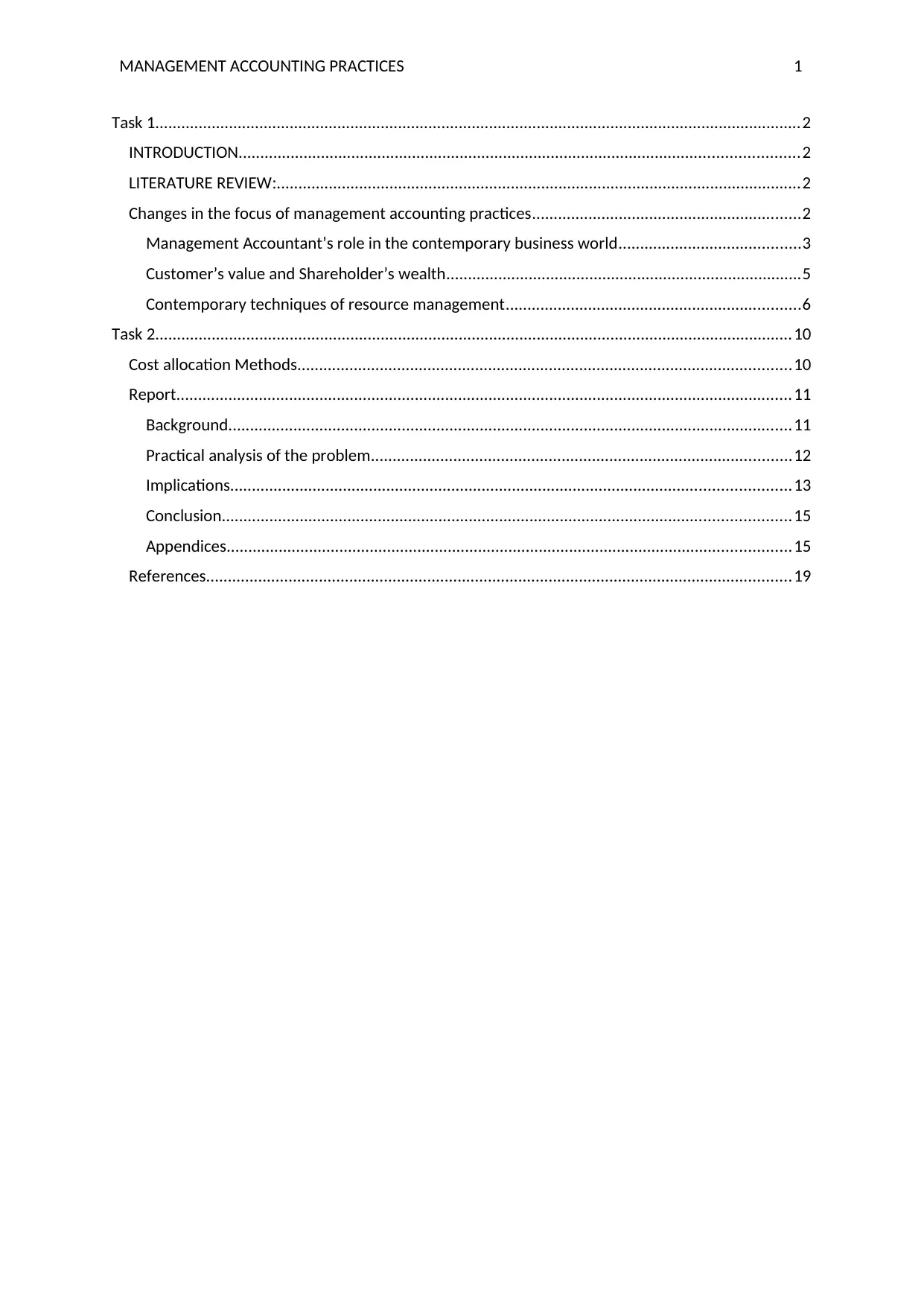
MANAGEMENT ACCOUNTING PRACTICES 1
Task 1.....................................................................................................................................................2
INTRODUCTION.................................................................................................................................2
LITERATURE REVIEW:.........................................................................................................................2
Changes in the focus of management accounting practices..............................................................2
Management Accountant’s role in the contemporary business world..........................................3
Customer’s value and Shareholder’s wealth..................................................................................5
Contemporary techniques of resource management....................................................................6
Task 2...................................................................................................................................................10
Cost allocation Methods..................................................................................................................10
Report..............................................................................................................................................11
Background..................................................................................................................................11
Practical analysis of the problem.................................................................................................12
Implications.................................................................................................................................13
Conclusion...................................................................................................................................15
Appendices..................................................................................................................................15
References.......................................................................................................................................19
Task 1.....................................................................................................................................................2
INTRODUCTION.................................................................................................................................2
LITERATURE REVIEW:.........................................................................................................................2
Changes in the focus of management accounting practices..............................................................2
Management Accountant’s role in the contemporary business world..........................................3
Customer’s value and Shareholder’s wealth..................................................................................5
Contemporary techniques of resource management....................................................................6
Task 2...................................................................................................................................................10
Cost allocation Methods..................................................................................................................10
Report..............................................................................................................................................11
Background..................................................................................................................................11
Practical analysis of the problem.................................................................................................12
Implications.................................................................................................................................13
Conclusion...................................................................................................................................15
Appendices..................................................................................................................................15
References.......................................................................................................................................19
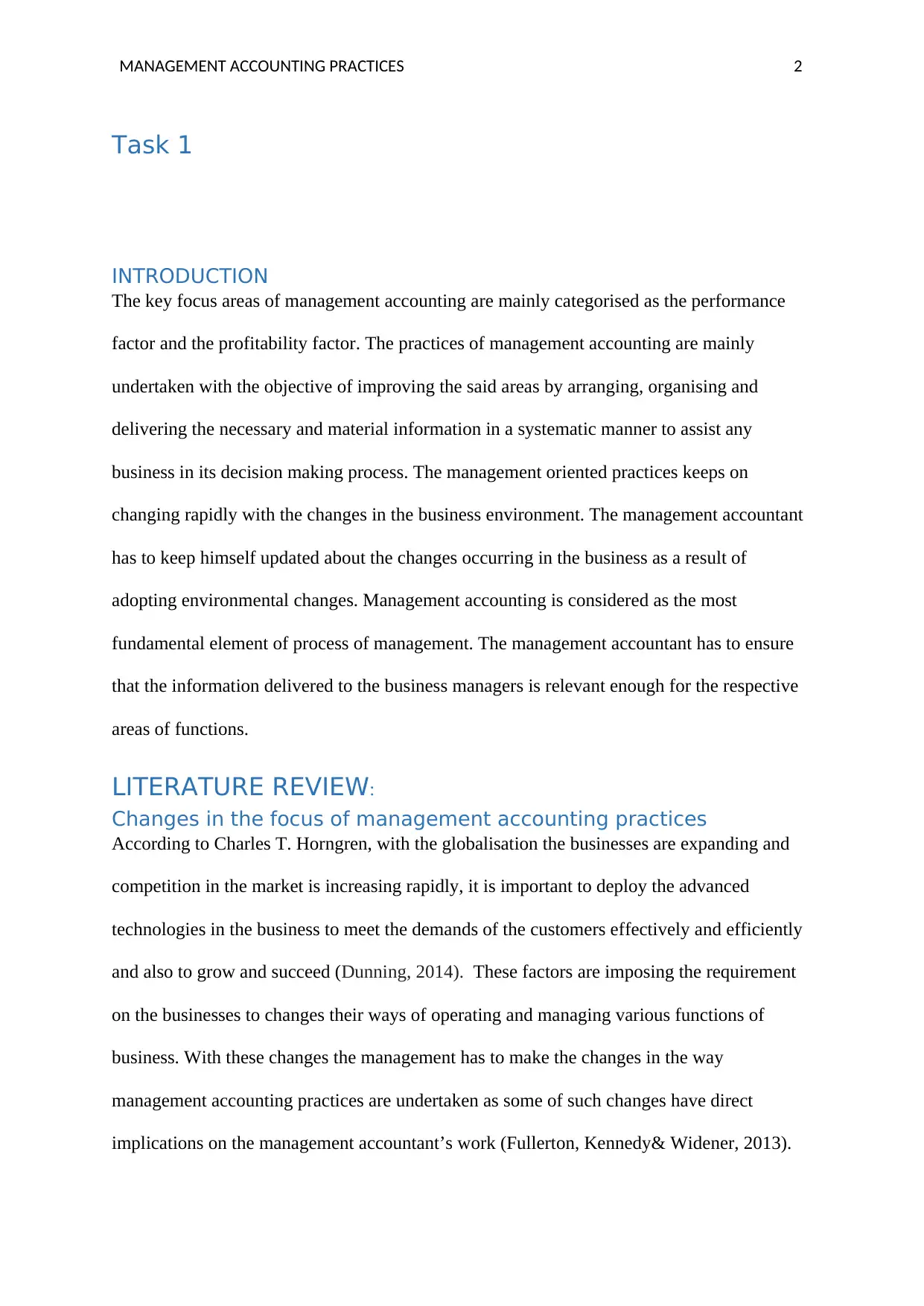
MANAGEMENT ACCOUNTING PRACTICES 2
Task 1
INTRODUCTION
The key focus areas of management accounting are mainly categorised as the performance
factor and the profitability factor. The practices of management accounting are mainly
undertaken with the objective of improving the said areas by arranging, organising and
delivering the necessary and material information in a systematic manner to assist any
business in its decision making process. The management oriented practices keeps on
changing rapidly with the changes in the business environment. The management accountant
has to keep himself updated about the changes occurring in the business as a result of
adopting environmental changes. Management accounting is considered as the most
fundamental element of process of management. The management accountant has to ensure
that the information delivered to the business managers is relevant enough for the respective
areas of functions.
LITERATURE REVIEW:
Changes in the focus of management accounting practices
According to Charles T. Horngren, with the globalisation the businesses are expanding and
competition in the market is increasing rapidly, it is important to deploy the advanced
technologies in the business to meet the demands of the customers effectively and efficiently
and also to grow and succeed (Dunning, 2014). These factors are imposing the requirement
on the businesses to changes their ways of operating and managing various functions of
business. With these changes the management has to make the changes in the way
management accounting practices are undertaken as some of such changes have direct
implications on the management accountant’s work (Fullerton, Kennedy& Widener, 2013).
Task 1
INTRODUCTION
The key focus areas of management accounting are mainly categorised as the performance
factor and the profitability factor. The practices of management accounting are mainly
undertaken with the objective of improving the said areas by arranging, organising and
delivering the necessary and material information in a systematic manner to assist any
business in its decision making process. The management oriented practices keeps on
changing rapidly with the changes in the business environment. The management accountant
has to keep himself updated about the changes occurring in the business as a result of
adopting environmental changes. Management accounting is considered as the most
fundamental element of process of management. The management accountant has to ensure
that the information delivered to the business managers is relevant enough for the respective
areas of functions.
LITERATURE REVIEW:
Changes in the focus of management accounting practices
According to Charles T. Horngren, with the globalisation the businesses are expanding and
competition in the market is increasing rapidly, it is important to deploy the advanced
technologies in the business to meet the demands of the customers effectively and efficiently
and also to grow and succeed (Dunning, 2014). These factors are imposing the requirement
on the businesses to changes their ways of operating and managing various functions of
business. With these changes the management has to make the changes in the way
management accounting practices are undertaken as some of such changes have direct
implications on the management accountant’s work (Fullerton, Kennedy& Widener, 2013).
⊘ This is a preview!⊘
Do you want full access?
Subscribe today to unlock all pages.

Trusted by 1+ million students worldwide
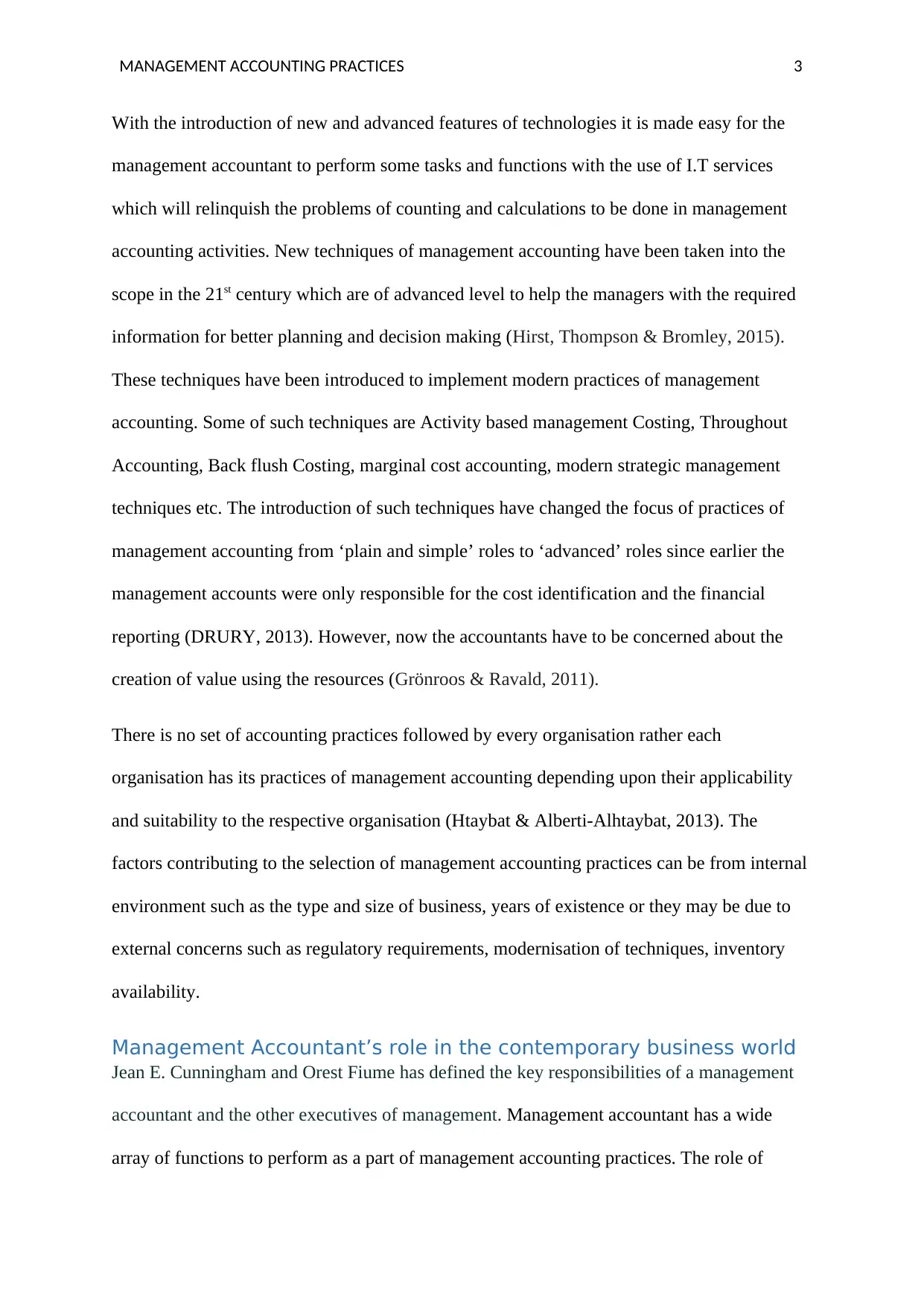
MANAGEMENT ACCOUNTING PRACTICES 3
With the introduction of new and advanced features of technologies it is made easy for the
management accountant to perform some tasks and functions with the use of I.T services
which will relinquish the problems of counting and calculations to be done in management
accounting activities. New techniques of management accounting have been taken into the
scope in the 21st century which are of advanced level to help the managers with the required
information for better planning and decision making (Hirst, Thompson & Bromley, 2015).
These techniques have been introduced to implement modern practices of management
accounting. Some of such techniques are Activity based management Costing, Throughout
Accounting, Back flush Costing, marginal cost accounting, modern strategic management
techniques etc. The introduction of such techniques have changed the focus of practices of
management accounting from ‘plain and simple’ roles to ‘advanced’ roles since earlier the
management accounts were only responsible for the cost identification and the financial
reporting (DRURY, 2013). However, now the accountants have to be concerned about the
creation of value using the resources (Grönroos & Ravald, 2011).
There is no set of accounting practices followed by every organisation rather each
organisation has its practices of management accounting depending upon their applicability
and suitability to the respective organisation (Htaybat & Alberti-Alhtaybat, 2013). The
factors contributing to the selection of management accounting practices can be from internal
environment such as the type and size of business, years of existence or they may be due to
external concerns such as regulatory requirements, modernisation of techniques, inventory
availability.
Management Accountant’s role in the contemporary business world
Jean E. Cunningham and Orest Fiume has defined the key responsibilities of a management
accountant and the other executives of management. Management accountant has a wide
array of functions to perform as a part of management accounting practices. The role of
With the introduction of new and advanced features of technologies it is made easy for the
management accountant to perform some tasks and functions with the use of I.T services
which will relinquish the problems of counting and calculations to be done in management
accounting activities. New techniques of management accounting have been taken into the
scope in the 21st century which are of advanced level to help the managers with the required
information for better planning and decision making (Hirst, Thompson & Bromley, 2015).
These techniques have been introduced to implement modern practices of management
accounting. Some of such techniques are Activity based management Costing, Throughout
Accounting, Back flush Costing, marginal cost accounting, modern strategic management
techniques etc. The introduction of such techniques have changed the focus of practices of
management accounting from ‘plain and simple’ roles to ‘advanced’ roles since earlier the
management accounts were only responsible for the cost identification and the financial
reporting (DRURY, 2013). However, now the accountants have to be concerned about the
creation of value using the resources (Grönroos & Ravald, 2011).
There is no set of accounting practices followed by every organisation rather each
organisation has its practices of management accounting depending upon their applicability
and suitability to the respective organisation (Htaybat & Alberti-Alhtaybat, 2013). The
factors contributing to the selection of management accounting practices can be from internal
environment such as the type and size of business, years of existence or they may be due to
external concerns such as regulatory requirements, modernisation of techniques, inventory
availability.
Management Accountant’s role in the contemporary business world
Jean E. Cunningham and Orest Fiume has defined the key responsibilities of a management
accountant and the other executives of management. Management accountant has a wide
array of functions to perform as a part of management accounting practices. The role of
Paraphrase This Document
Need a fresh take? Get an instant paraphrase of this document with our AI Paraphraser
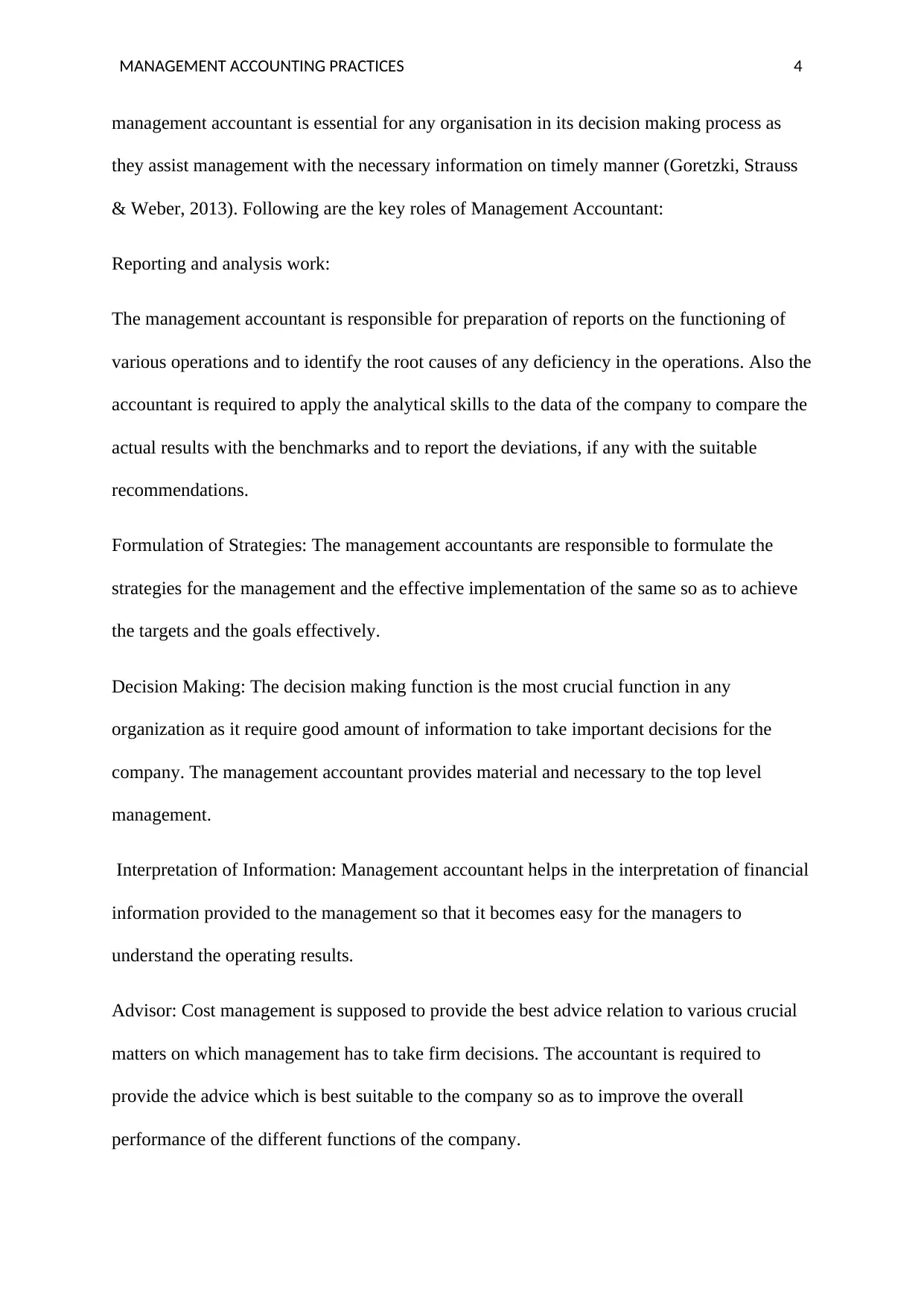
MANAGEMENT ACCOUNTING PRACTICES 4
management accountant is essential for any organisation in its decision making process as
they assist management with the necessary information on timely manner (Goretzki, Strauss
& Weber, 2013). Following are the key roles of Management Accountant:
Reporting and analysis work:
The management accountant is responsible for preparation of reports on the functioning of
various operations and to identify the root causes of any deficiency in the operations. Also the
accountant is required to apply the analytical skills to the data of the company to compare the
actual results with the benchmarks and to report the deviations, if any with the suitable
recommendations.
Formulation of Strategies: The management accountants are responsible to formulate the
strategies for the management and the effective implementation of the same so as to achieve
the targets and the goals effectively.
Decision Making: The decision making function is the most crucial function in any
organization as it require good amount of information to take important decisions for the
company. The management accountant provides material and necessary to the top level
management.
Interpretation of Information: Management accountant helps in the interpretation of financial
information provided to the management so that it becomes easy for the managers to
understand the operating results.
Advisor: Cost management is supposed to provide the best advice relation to various crucial
matters on which management has to take firm decisions. The accountant is required to
provide the advice which is best suitable to the company so as to improve the overall
performance of the different functions of the company.
management accountant is essential for any organisation in its decision making process as
they assist management with the necessary information on timely manner (Goretzki, Strauss
& Weber, 2013). Following are the key roles of Management Accountant:
Reporting and analysis work:
The management accountant is responsible for preparation of reports on the functioning of
various operations and to identify the root causes of any deficiency in the operations. Also the
accountant is required to apply the analytical skills to the data of the company to compare the
actual results with the benchmarks and to report the deviations, if any with the suitable
recommendations.
Formulation of Strategies: The management accountants are responsible to formulate the
strategies for the management and the effective implementation of the same so as to achieve
the targets and the goals effectively.
Decision Making: The decision making function is the most crucial function in any
organization as it require good amount of information to take important decisions for the
company. The management accountant provides material and necessary to the top level
management.
Interpretation of Information: Management accountant helps in the interpretation of financial
information provided to the management so that it becomes easy for the managers to
understand the operating results.
Advisor: Cost management is supposed to provide the best advice relation to various crucial
matters on which management has to take firm decisions. The accountant is required to
provide the advice which is best suitable to the company so as to improve the overall
performance of the different functions of the company.
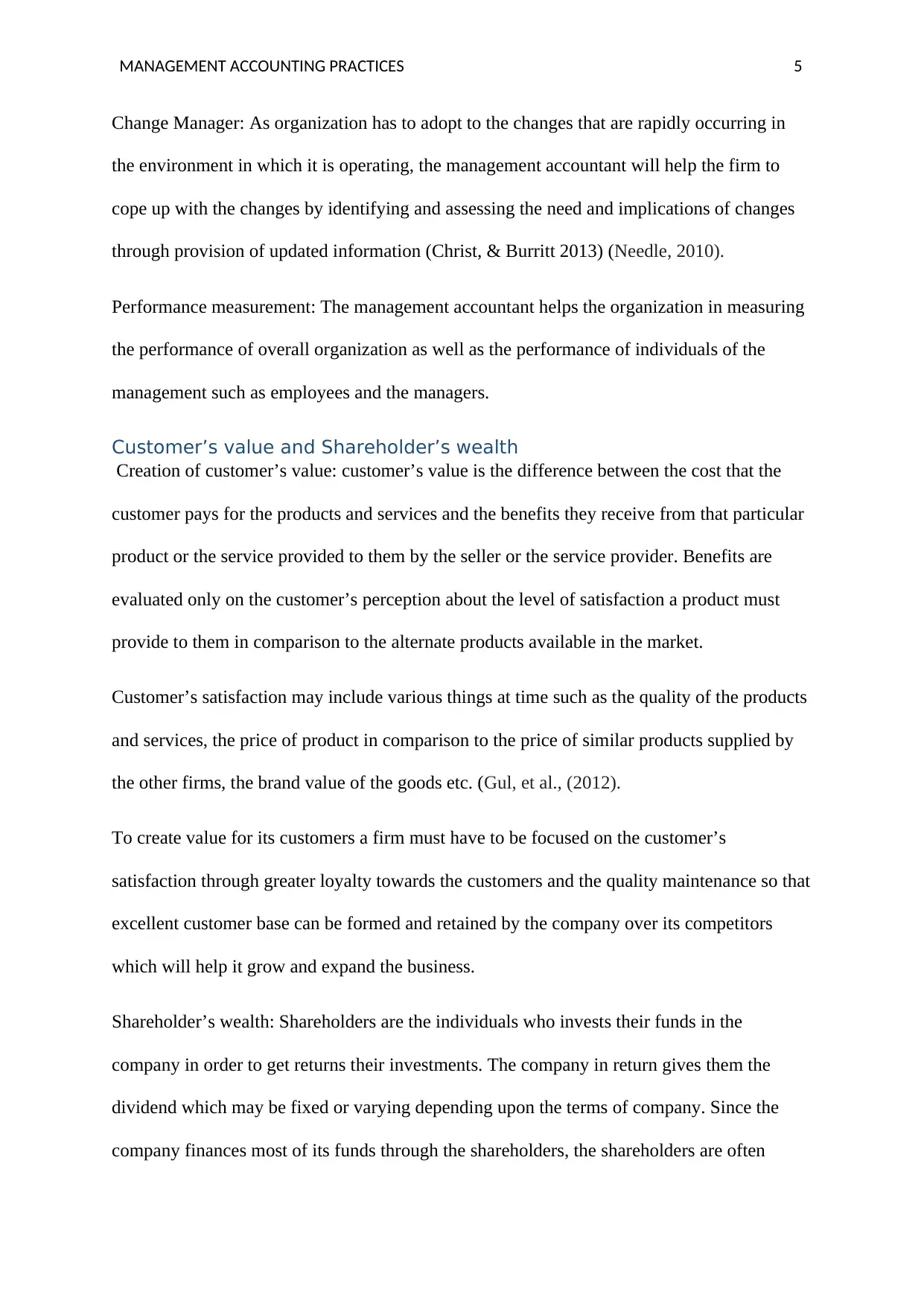
MANAGEMENT ACCOUNTING PRACTICES 5
Change Manager: As organization has to adopt to the changes that are rapidly occurring in
the environment in which it is operating, the management accountant will help the firm to
cope up with the changes by identifying and assessing the need and implications of changes
through provision of updated information (Christ, & Burritt 2013) (Needle, 2010).
Performance measurement: The management accountant helps the organization in measuring
the performance of overall organization as well as the performance of individuals of the
management such as employees and the managers.
Customer’s value and Shareholder’s wealth
Creation of customer’s value: customer’s value is the difference between the cost that the
customer pays for the products and services and the benefits they receive from that particular
product or the service provided to them by the seller or the service provider. Benefits are
evaluated only on the customer’s perception about the level of satisfaction a product must
provide to them in comparison to the alternate products available in the market.
Customer’s satisfaction may include various things at time such as the quality of the products
and services, the price of product in comparison to the price of similar products supplied by
the other firms, the brand value of the goods etc. (Gul, et al., (2012).
To create value for its customers a firm must have to be focused on the customer’s
satisfaction through greater loyalty towards the customers and the quality maintenance so that
excellent customer base can be formed and retained by the company over its competitors
which will help it grow and expand the business.
Shareholder’s wealth: Shareholders are the individuals who invests their funds in the
company in order to get returns their investments. The company in return gives them the
dividend which may be fixed or varying depending upon the terms of company. Since the
company finances most of its funds through the shareholders, the shareholders are often
Change Manager: As organization has to adopt to the changes that are rapidly occurring in
the environment in which it is operating, the management accountant will help the firm to
cope up with the changes by identifying and assessing the need and implications of changes
through provision of updated information (Christ, & Burritt 2013) (Needle, 2010).
Performance measurement: The management accountant helps the organization in measuring
the performance of overall organization as well as the performance of individuals of the
management such as employees and the managers.
Customer’s value and Shareholder’s wealth
Creation of customer’s value: customer’s value is the difference between the cost that the
customer pays for the products and services and the benefits they receive from that particular
product or the service provided to them by the seller or the service provider. Benefits are
evaluated only on the customer’s perception about the level of satisfaction a product must
provide to them in comparison to the alternate products available in the market.
Customer’s satisfaction may include various things at time such as the quality of the products
and services, the price of product in comparison to the price of similar products supplied by
the other firms, the brand value of the goods etc. (Gul, et al., (2012).
To create value for its customers a firm must have to be focused on the customer’s
satisfaction through greater loyalty towards the customers and the quality maintenance so that
excellent customer base can be formed and retained by the company over its competitors
which will help it grow and expand the business.
Shareholder’s wealth: Shareholders are the individuals who invests their funds in the
company in order to get returns their investments. The company in return gives them the
dividend which may be fixed or varying depending upon the terms of company. Since the
company finances most of its funds through the shareholders, the shareholders are often
⊘ This is a preview!⊘
Do you want full access?
Subscribe today to unlock all pages.

Trusted by 1+ million students worldwide
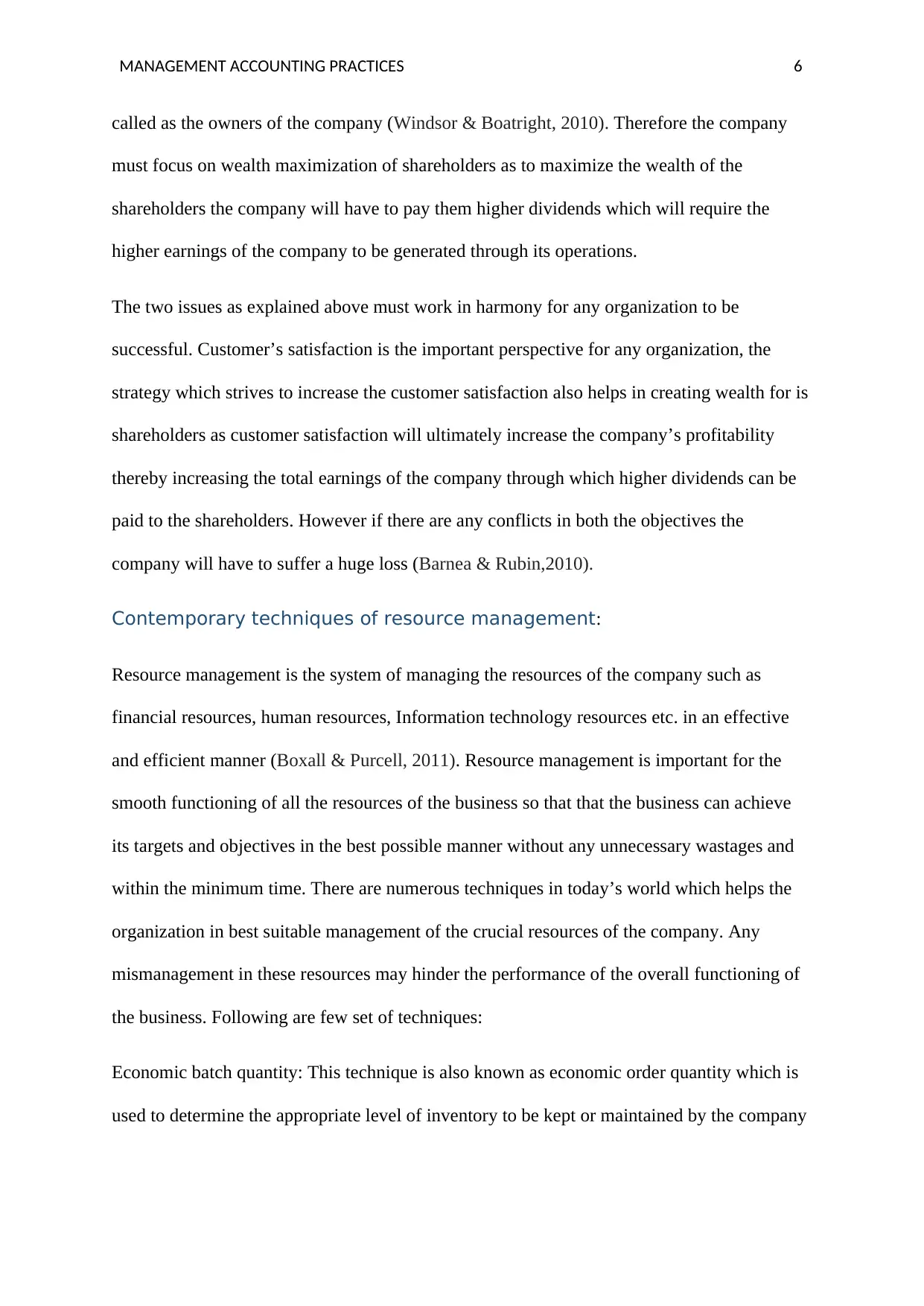
MANAGEMENT ACCOUNTING PRACTICES 6
called as the owners of the company (Windsor & Boatright, 2010). Therefore the company
must focus on wealth maximization of shareholders as to maximize the wealth of the
shareholders the company will have to pay them higher dividends which will require the
higher earnings of the company to be generated through its operations.
The two issues as explained above must work in harmony for any organization to be
successful. Customer’s satisfaction is the important perspective for any organization, the
strategy which strives to increase the customer satisfaction also helps in creating wealth for is
shareholders as customer satisfaction will ultimately increase the company’s profitability
thereby increasing the total earnings of the company through which higher dividends can be
paid to the shareholders. However if there are any conflicts in both the objectives the
company will have to suffer a huge loss (Barnea & Rubin,2010).
Contemporary techniques of resource management:
Resource management is the system of managing the resources of the company such as
financial resources, human resources, Information technology resources etc. in an effective
and efficient manner (Boxall & Purcell, 2011). Resource management is important for the
smooth functioning of all the resources of the business so that that the business can achieve
its targets and objectives in the best possible manner without any unnecessary wastages and
within the minimum time. There are numerous techniques in today’s world which helps the
organization in best suitable management of the crucial resources of the company. Any
mismanagement in these resources may hinder the performance of the overall functioning of
the business. Following are few set of techniques:
Economic batch quantity: This technique is also known as economic order quantity which is
used to determine the appropriate level of inventory to be kept or maintained by the company
called as the owners of the company (Windsor & Boatright, 2010). Therefore the company
must focus on wealth maximization of shareholders as to maximize the wealth of the
shareholders the company will have to pay them higher dividends which will require the
higher earnings of the company to be generated through its operations.
The two issues as explained above must work in harmony for any organization to be
successful. Customer’s satisfaction is the important perspective for any organization, the
strategy which strives to increase the customer satisfaction also helps in creating wealth for is
shareholders as customer satisfaction will ultimately increase the company’s profitability
thereby increasing the total earnings of the company through which higher dividends can be
paid to the shareholders. However if there are any conflicts in both the objectives the
company will have to suffer a huge loss (Barnea & Rubin,2010).
Contemporary techniques of resource management:
Resource management is the system of managing the resources of the company such as
financial resources, human resources, Information technology resources etc. in an effective
and efficient manner (Boxall & Purcell, 2011). Resource management is important for the
smooth functioning of all the resources of the business so that that the business can achieve
its targets and objectives in the best possible manner without any unnecessary wastages and
within the minimum time. There are numerous techniques in today’s world which helps the
organization in best suitable management of the crucial resources of the company. Any
mismanagement in these resources may hinder the performance of the overall functioning of
the business. Following are few set of techniques:
Economic batch quantity: This technique is also known as economic order quantity which is
used to determine the appropriate level of inventory to be kept or maintained by the company
Paraphrase This Document
Need a fresh take? Get an instant paraphrase of this document with our AI Paraphraser
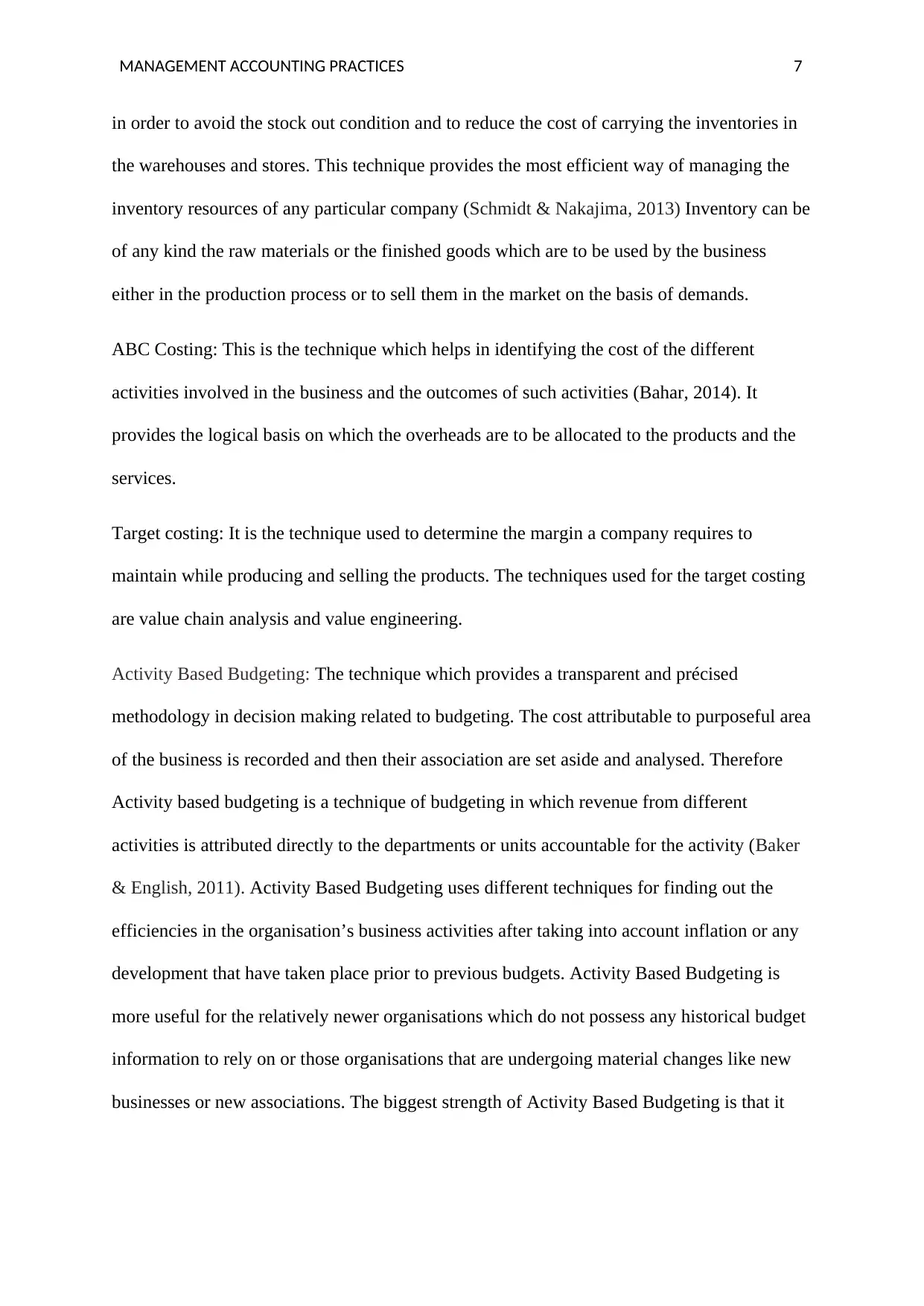
MANAGEMENT ACCOUNTING PRACTICES 7
in order to avoid the stock out condition and to reduce the cost of carrying the inventories in
the warehouses and stores. This technique provides the most efficient way of managing the
inventory resources of any particular company (Schmidt & Nakajima, 2013) Inventory can be
of any kind the raw materials or the finished goods which are to be used by the business
either in the production process or to sell them in the market on the basis of demands.
ABC Costing: This is the technique which helps in identifying the cost of the different
activities involved in the business and the outcomes of such activities (Bahar, 2014). It
provides the logical basis on which the overheads are to be allocated to the products and the
services.
Target costing: It is the technique used to determine the margin a company requires to
maintain while producing and selling the products. The techniques used for the target costing
are value chain analysis and value engineering.
Activity Based Budgeting: The technique which provides a transparent and précised
methodology in decision making related to budgeting. The cost attributable to purposeful area
of the business is recorded and then their association are set aside and analysed. Therefore
Activity based budgeting is a technique of budgeting in which revenue from different
activities is attributed directly to the departments or units accountable for the activity (Baker
& English, 2011). Activity Based Budgeting uses different techniques for finding out the
efficiencies in the organisation’s business activities after taking into account inflation or any
development that have taken place prior to previous budgets. Activity Based Budgeting is
more useful for the relatively newer organisations which do not possess any historical budget
information to rely on or those organisations that are undergoing material changes like new
businesses or new associations. The biggest strength of Activity Based Budgeting is that it
in order to avoid the stock out condition and to reduce the cost of carrying the inventories in
the warehouses and stores. This technique provides the most efficient way of managing the
inventory resources of any particular company (Schmidt & Nakajima, 2013) Inventory can be
of any kind the raw materials or the finished goods which are to be used by the business
either in the production process or to sell them in the market on the basis of demands.
ABC Costing: This is the technique which helps in identifying the cost of the different
activities involved in the business and the outcomes of such activities (Bahar, 2014). It
provides the logical basis on which the overheads are to be allocated to the products and the
services.
Target costing: It is the technique used to determine the margin a company requires to
maintain while producing and selling the products. The techniques used for the target costing
are value chain analysis and value engineering.
Activity Based Budgeting: The technique which provides a transparent and précised
methodology in decision making related to budgeting. The cost attributable to purposeful area
of the business is recorded and then their association are set aside and analysed. Therefore
Activity based budgeting is a technique of budgeting in which revenue from different
activities is attributed directly to the departments or units accountable for the activity (Baker
& English, 2011). Activity Based Budgeting uses different techniques for finding out the
efficiencies in the organisation’s business activities after taking into account inflation or any
development that have taken place prior to previous budgets. Activity Based Budgeting is
more useful for the relatively newer organisations which do not possess any historical budget
information to rely on or those organisations that are undergoing material changes like new
businesses or new associations. The biggest strength of Activity Based Budgeting is that it
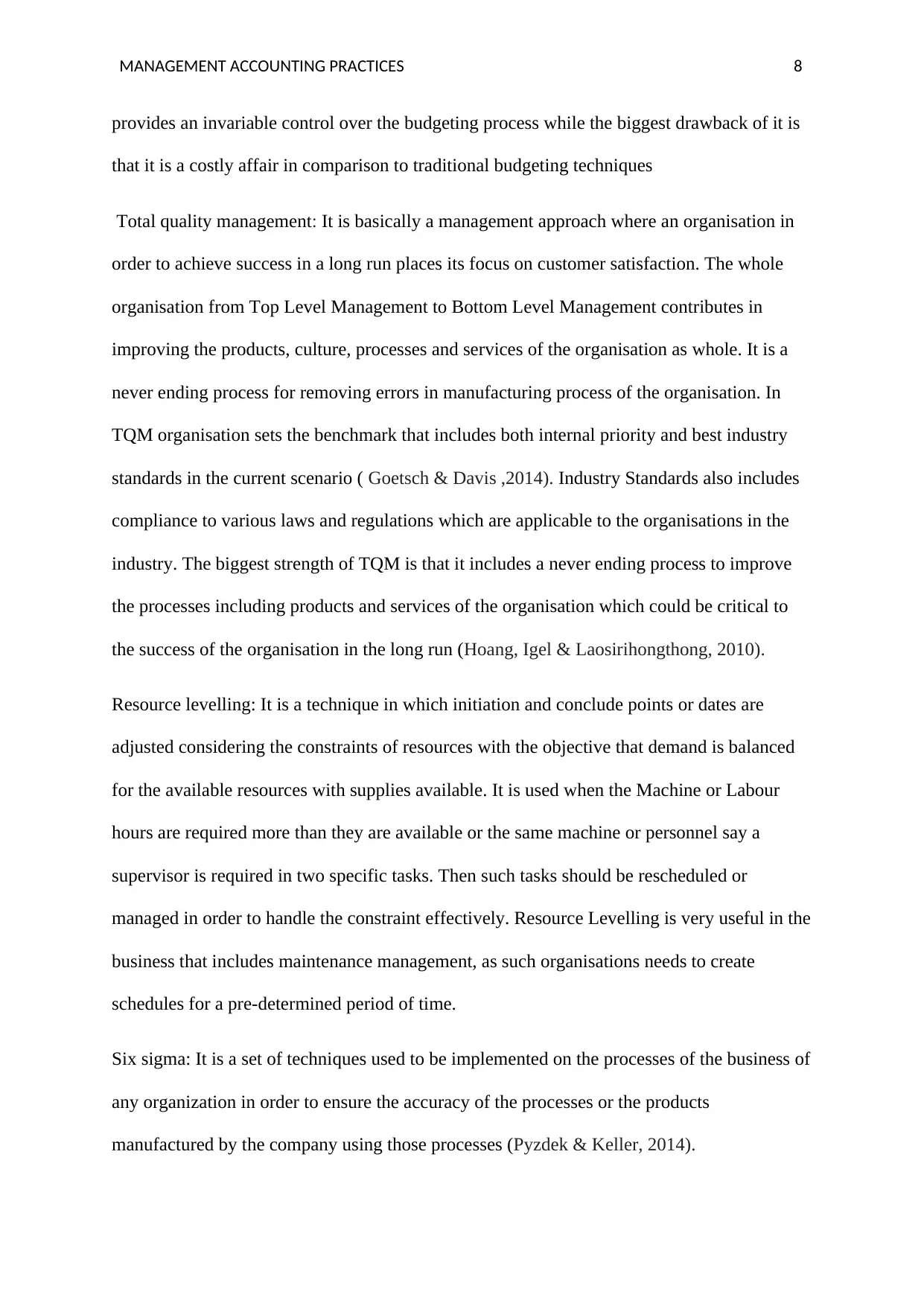
MANAGEMENT ACCOUNTING PRACTICES 8
provides an invariable control over the budgeting process while the biggest drawback of it is
that it is a costly affair in comparison to traditional budgeting techniques
Total quality management: It is basically a management approach where an organisation in
order to achieve success in a long run places its focus on customer satisfaction. The whole
organisation from Top Level Management to Bottom Level Management contributes in
improving the products, culture, processes and services of the organisation as whole. It is a
never ending process for removing errors in manufacturing process of the organisation. In
TQM organisation sets the benchmark that includes both internal priority and best industry
standards in the current scenario ( Goetsch & Davis ,2014). Industry Standards also includes
compliance to various laws and regulations which are applicable to the organisations in the
industry. The biggest strength of TQM is that it includes a never ending process to improve
the processes including products and services of the organisation which could be critical to
the success of the organisation in the long run (Hoang, Igel & Laosirihongthong, 2010).
Resource levelling: It is a technique in which initiation and conclude points or dates are
adjusted considering the constraints of resources with the objective that demand is balanced
for the available resources with supplies available. It is used when the Machine or Labour
hours are required more than they are available or the same machine or personnel say a
supervisor is required in two specific tasks. Then such tasks should be rescheduled or
managed in order to handle the constraint effectively. Resource Levelling is very useful in the
business that includes maintenance management, as such organisations needs to create
schedules for a pre-determined period of time.
Six sigma: It is a set of techniques used to be implemented on the processes of the business of
any organization in order to ensure the accuracy of the processes or the products
manufactured by the company using those processes (Pyzdek & Keller, 2014).
provides an invariable control over the budgeting process while the biggest drawback of it is
that it is a costly affair in comparison to traditional budgeting techniques
Total quality management: It is basically a management approach where an organisation in
order to achieve success in a long run places its focus on customer satisfaction. The whole
organisation from Top Level Management to Bottom Level Management contributes in
improving the products, culture, processes and services of the organisation as whole. It is a
never ending process for removing errors in manufacturing process of the organisation. In
TQM organisation sets the benchmark that includes both internal priority and best industry
standards in the current scenario ( Goetsch & Davis ,2014). Industry Standards also includes
compliance to various laws and regulations which are applicable to the organisations in the
industry. The biggest strength of TQM is that it includes a never ending process to improve
the processes including products and services of the organisation which could be critical to
the success of the organisation in the long run (Hoang, Igel & Laosirihongthong, 2010).
Resource levelling: It is a technique in which initiation and conclude points or dates are
adjusted considering the constraints of resources with the objective that demand is balanced
for the available resources with supplies available. It is used when the Machine or Labour
hours are required more than they are available or the same machine or personnel say a
supervisor is required in two specific tasks. Then such tasks should be rescheduled or
managed in order to handle the constraint effectively. Resource Levelling is very useful in the
business that includes maintenance management, as such organisations needs to create
schedules for a pre-determined period of time.
Six sigma: It is a set of techniques used to be implemented on the processes of the business of
any organization in order to ensure the accuracy of the processes or the products
manufactured by the company using those processes (Pyzdek & Keller, 2014).
⊘ This is a preview!⊘
Do you want full access?
Subscribe today to unlock all pages.

Trusted by 1+ million students worldwide
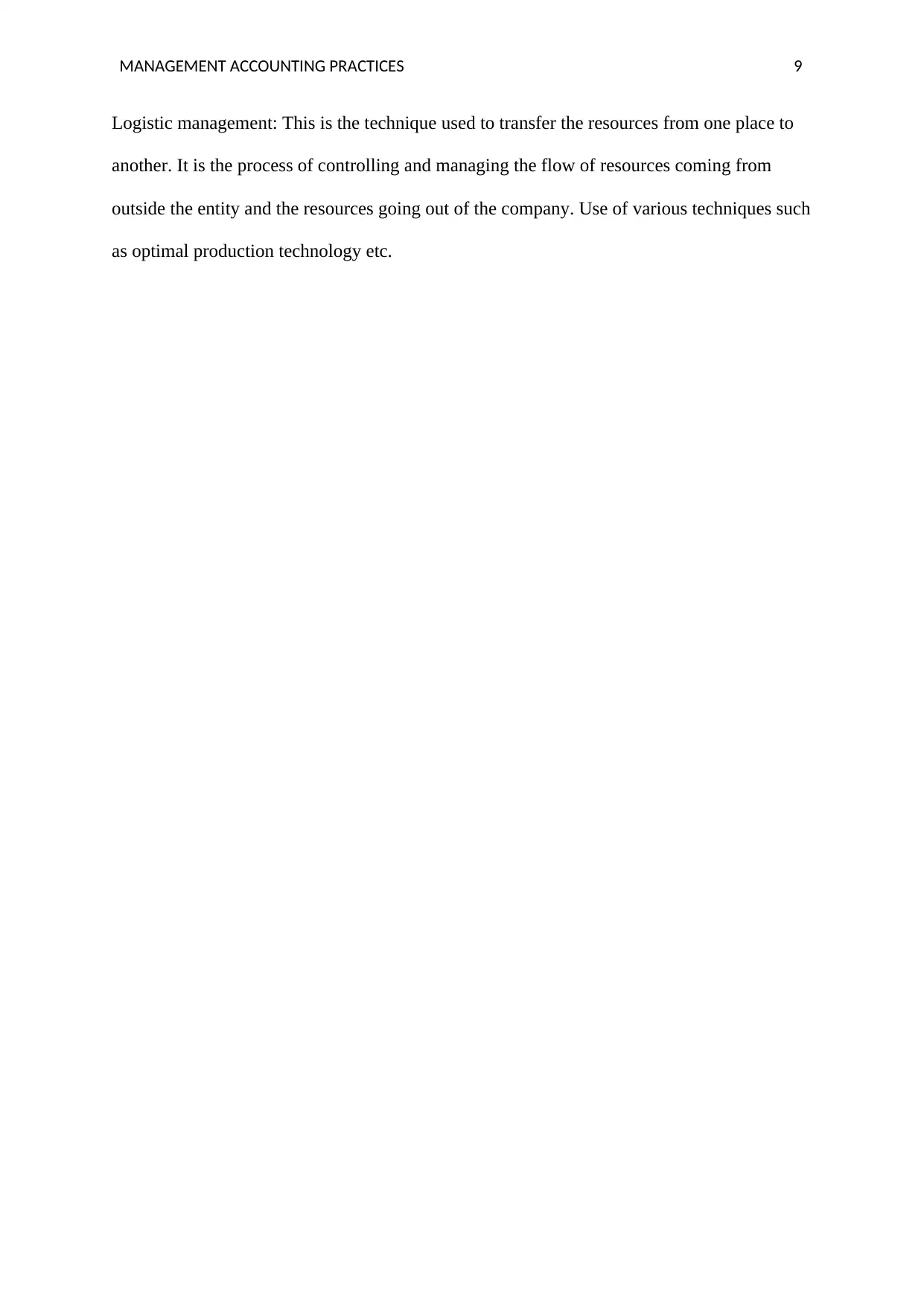
MANAGEMENT ACCOUNTING PRACTICES 9
Logistic management: This is the technique used to transfer the resources from one place to
another. It is the process of controlling and managing the flow of resources coming from
outside the entity and the resources going out of the company. Use of various techniques such
as optimal production technology etc.
Logistic management: This is the technique used to transfer the resources from one place to
another. It is the process of controlling and managing the flow of resources coming from
outside the entity and the resources going out of the company. Use of various techniques such
as optimal production technology etc.
Paraphrase This Document
Need a fresh take? Get an instant paraphrase of this document with our AI Paraphraser
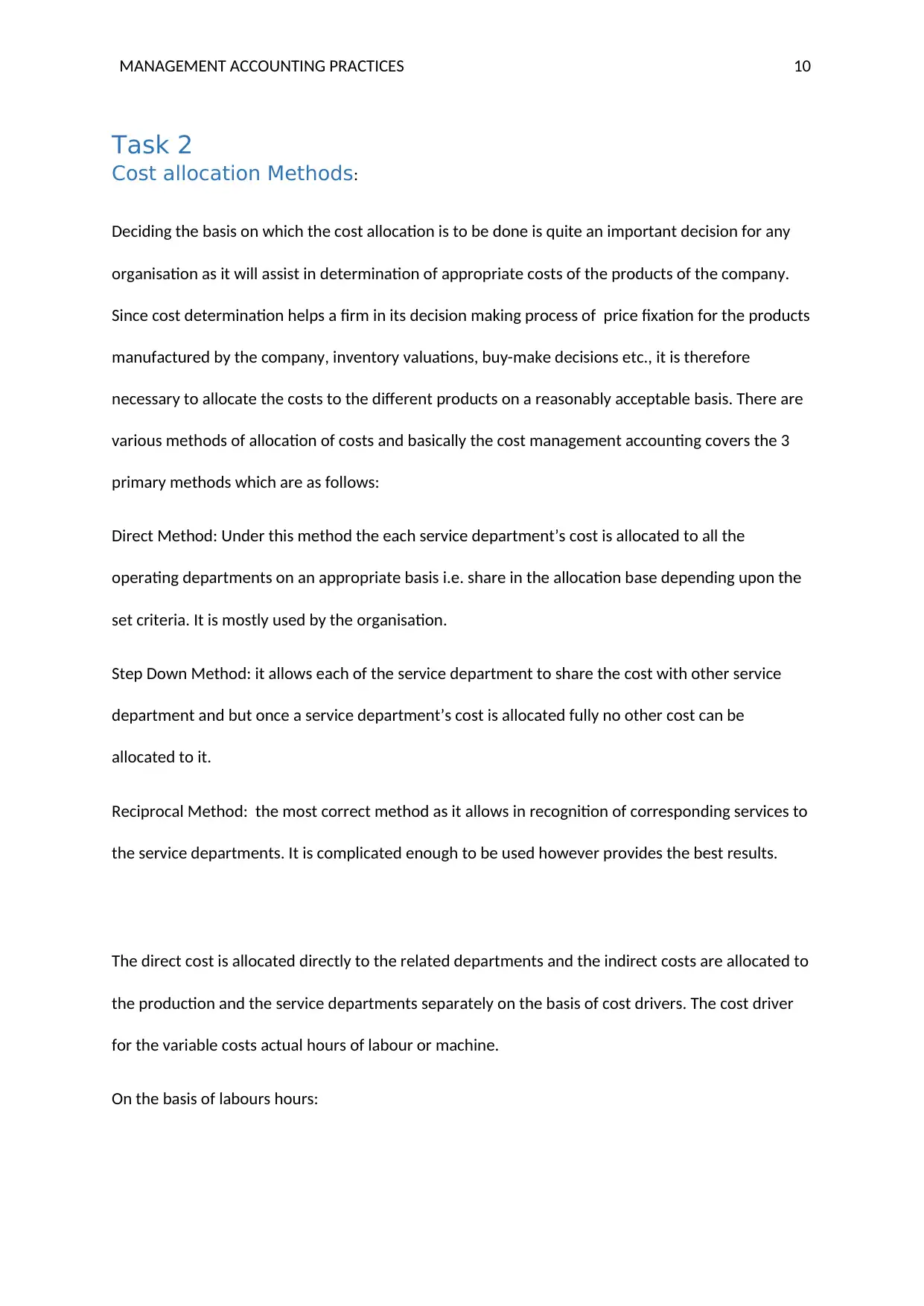
MANAGEMENT ACCOUNTING PRACTICES 10
Task 2
Cost allocation Methods:
Deciding the basis on which the cost allocation is to be done is quite an important decision for any
organisation as it will assist in determination of appropriate costs of the products of the company.
Since cost determination helps a firm in its decision making process of price fixation for the products
manufactured by the company, inventory valuations, buy-make decisions etc., it is therefore
necessary to allocate the costs to the different products on a reasonably acceptable basis. There are
various methods of allocation of costs and basically the cost management accounting covers the 3
primary methods which are as follows:
Direct Method: Under this method the each service department’s cost is allocated to all the
operating departments on an appropriate basis i.e. share in the allocation base depending upon the
set criteria. It is mostly used by the organisation.
Step Down Method: it allows each of the service department to share the cost with other service
department and but once a service department’s cost is allocated fully no other cost can be
allocated to it.
Reciprocal Method: the most correct method as it allows in recognition of corresponding services to
the service departments. It is complicated enough to be used however provides the best results.
The direct cost is allocated directly to the related departments and the indirect costs are allocated to
the production and the service departments separately on the basis of cost drivers. The cost driver
for the variable costs actual hours of labour or machine.
On the basis of labours hours:
Task 2
Cost allocation Methods:
Deciding the basis on which the cost allocation is to be done is quite an important decision for any
organisation as it will assist in determination of appropriate costs of the products of the company.
Since cost determination helps a firm in its decision making process of price fixation for the products
manufactured by the company, inventory valuations, buy-make decisions etc., it is therefore
necessary to allocate the costs to the different products on a reasonably acceptable basis. There are
various methods of allocation of costs and basically the cost management accounting covers the 3
primary methods which are as follows:
Direct Method: Under this method the each service department’s cost is allocated to all the
operating departments on an appropriate basis i.e. share in the allocation base depending upon the
set criteria. It is mostly used by the organisation.
Step Down Method: it allows each of the service department to share the cost with other service
department and but once a service department’s cost is allocated fully no other cost can be
allocated to it.
Reciprocal Method: the most correct method as it allows in recognition of corresponding services to
the service departments. It is complicated enough to be used however provides the best results.
The direct cost is allocated directly to the related departments and the indirect costs are allocated to
the production and the service departments separately on the basis of cost drivers. The cost driver
for the variable costs actual hours of labour or machine.
On the basis of labours hours:
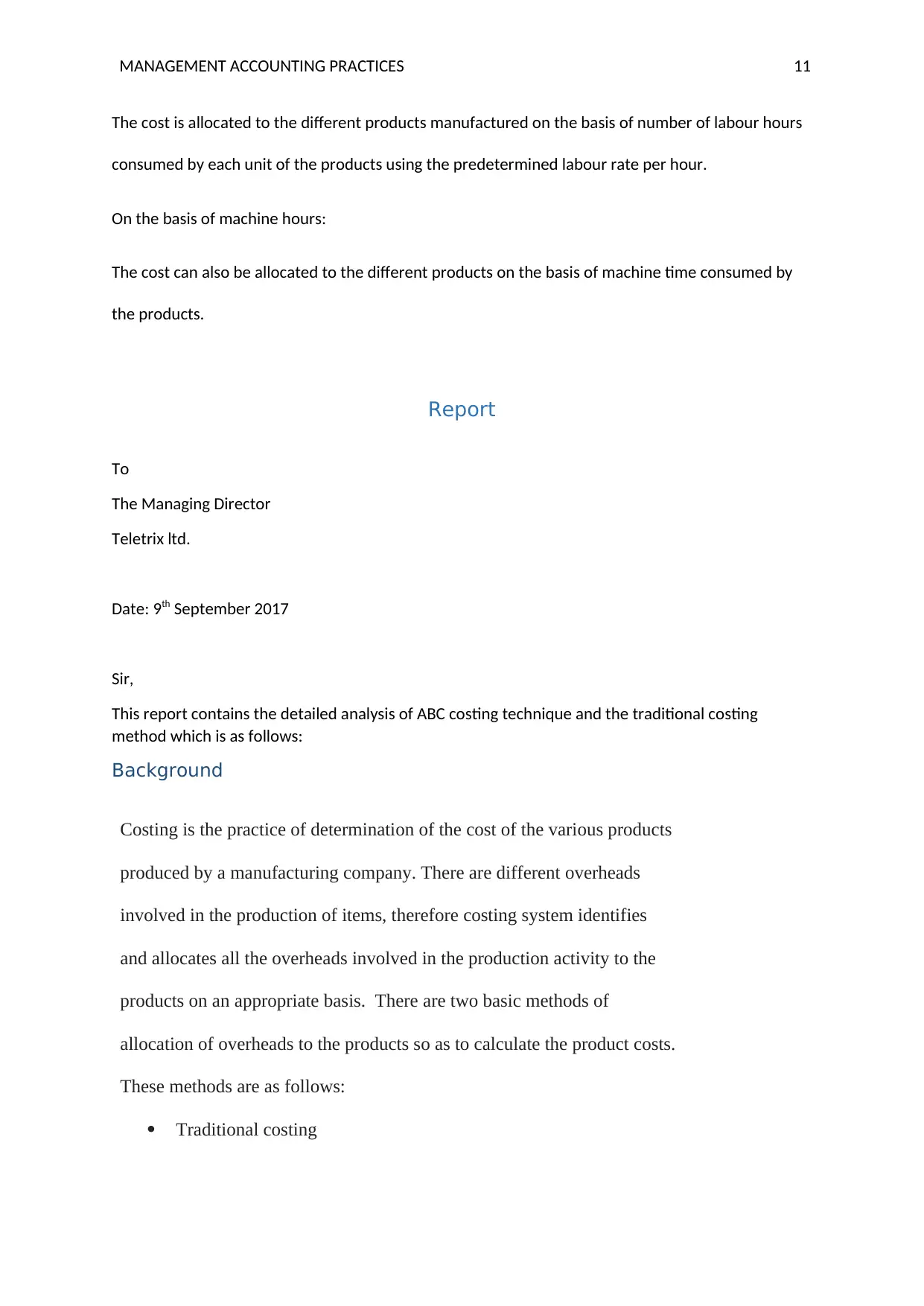
MANAGEMENT ACCOUNTING PRACTICES 11
The cost is allocated to the different products manufactured on the basis of number of labour hours
consumed by each unit of the products using the predetermined labour rate per hour.
On the basis of machine hours:
The cost can also be allocated to the different products on the basis of machine time consumed by
the products.
Report
To
The Managing Director
Teletrix ltd.
Date: 9th September 2017
Sir,
This report contains the detailed analysis of ABC costing technique and the traditional costing
method which is as follows:
Background
Costing is the practice of determination of the cost of the various products
produced by a manufacturing company. There are different overheads
involved in the production of items, therefore costing system identifies
and allocates all the overheads involved in the production activity to the
products on an appropriate basis. There are two basic methods of
allocation of overheads to the products so as to calculate the product costs.
These methods are as follows:
Traditional costing
The cost is allocated to the different products manufactured on the basis of number of labour hours
consumed by each unit of the products using the predetermined labour rate per hour.
On the basis of machine hours:
The cost can also be allocated to the different products on the basis of machine time consumed by
the products.
Report
To
The Managing Director
Teletrix ltd.
Date: 9th September 2017
Sir,
This report contains the detailed analysis of ABC costing technique and the traditional costing
method which is as follows:
Background
Costing is the practice of determination of the cost of the various products
produced by a manufacturing company. There are different overheads
involved in the production of items, therefore costing system identifies
and allocates all the overheads involved in the production activity to the
products on an appropriate basis. There are two basic methods of
allocation of overheads to the products so as to calculate the product costs.
These methods are as follows:
Traditional costing
⊘ This is a preview!⊘
Do you want full access?
Subscribe today to unlock all pages.

Trusted by 1+ million students worldwide
1 out of 23
Related Documents
Your All-in-One AI-Powered Toolkit for Academic Success.
+13062052269
info@desklib.com
Available 24*7 on WhatsApp / Email
![[object Object]](/_next/static/media/star-bottom.7253800d.svg)
Unlock your academic potential
Copyright © 2020–2025 A2Z Services. All Rights Reserved. Developed and managed by ZUCOL.




